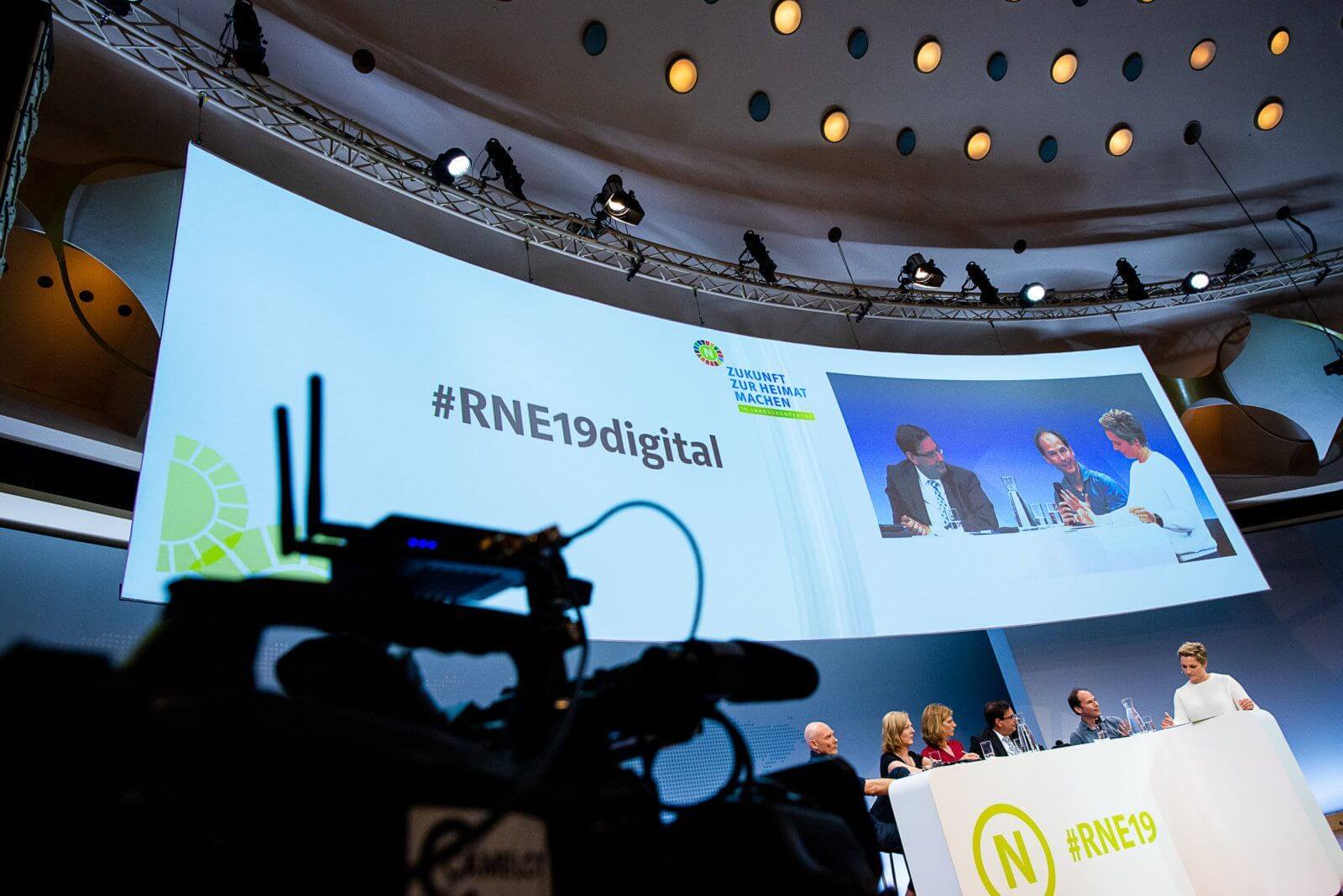In the wake of the coronavirus crisis, digitalisation has been given a significant push forward – in event management as well. How strongly emissions will fall as a result is, however, difficult to quantify.

Photo: Andre Wagenzik/Andreas Domma © RNE
From the Olympic Games to the Met Gala to the Rolling Stones’ next tour: around the world countless events have been cancelled as a result of the coronavirus pandemic. A list published by the New York Times provides a glimpse, but touches on only the biggest of these. Some have been cancelled entirely, but many have been relocated in one way or another to the digital space – the German Council for Sustainable Development (RNE), for instance, also opted for the virtual format in holding its conference online.
One thing is for sure: the accelerated digitalisation has been resulting in fewer emissions being generated, starting quite simply with the fact that the participants are no longer travelling to the event. However, it is considerably more difficult to answer the question of how much lower the emissions are precisely. Such quantification would provide insight not only for research purposes but would also be of interest to event organisers who wish to compensate for the emissions of their digital events. Currently, there are only estimates.
69 kilogrammes of CO2 instead of 52 tonnes?
In the course of a thought experiment regarding his organisation’s last annual congress, Jan Rüter from nachhaltig.digital, a platform bundling sustainability and digitalisation competence for SMEs, arrived at an eye-opening result: a virtual conference would have produced only 69 kilogrammes of CO2 emissions instead of the actual 52 tonnes and would thus have been significantly more climate-friendly.
“We can only ever estimate the impact, of course,” the researcher responsible for the project’s content development explains. “Many influencing factors depend on people’s personal decisions and are thus difficult to assess.” The choice, for instance, of what transport method participants would take to the event or if they used an old desktop PC or a new laptop – which has a significantly larger ecological footprint – for participation in the online conference. In addition to the hardware used, other factors like browser settings can play a role: ad blockers lower emissions, for example.
Break even at 75 hours of digital meeting?
One tricky issue is in particular differentiating between the various emission sources as they are categorised by the Greenhouse Gas Protocol, i.e. into Scopes 1, 2 and 3. “In my opinion, many of the studies currently being carried out are quite superficial in design,” adds Johanna Buchmann, Sustainability Analyst at the start-up planet.ly, which offers software for intelligent CO2 management. The most in-depth study on the topic Buchmann is aware of dates back to the year 2012. According to that study, a digital meeting would have to last 75 hours in order to break even with a conference held in the real world. Even this calculation still excludes certain factors, however, Buchmann reminds us: “If the participants sit at an event for five hours, they have – hopefully – turned off electrical appliances and the heating in their apartment or office.” How to calculate the savings this entails remains yet unclear.
Factors like the emissions load resulting from catering are also difficult to assess without in-depth research, she points out: “Where are the ingredients coming from? How is the food being prepared? How are the service staff travelling to the location?” All these are questions that will impact the carbon footprint of an event. But participants of an online conference must eat, too – and that effect is almost impossible to assess.
In particular, she emphasises, it is currently not clear where in all these considerations the line should be drawn: “How is the furniture in the rented event rooms to be factored in? And what about the on-site hardware there?” Buchmann asks. “Most importantly, does it make sense to take these things into account? At home you sit on a chair as well.” Currently, there is no consensus regarding all these components.
Hybrid events as a solution
One thing at least is clear, and that is that travel to an event is the decisive factor: “If everyone came to a physical conference by bike or on foot, the video conference would carry the larger burden for the environment,” Buchmann from planet.ly explains. As this is not the case, travel is responsible for up to 75 per cent of the emissions generated.
Oliver Wulf assumes a value of “at least 30 per cent” for major events. Wolf is Managing Director of raumobil, a consulting firm specialised in the mobility environment in relation to digitalisation. He hopes that one lesson learnt from the coronavirus crisis could be to “cancel 50 per cent of unnecessary meetings and replace them with a videoconference.” This could boost the value of in-person events further and would make them “more interesting and intensive”. Moreover, it would be nice, he says, if going forward event locations were selected more carefully with a view to minimising the travel necessary for participants.
Experts are in agreement that virtual conferences have many advantages for the climate. However, “they will never be able to replace personal meetings in the real world,” comments Rüter from nachhaltig.digital. He hopes that the changes necessitated by the coronavirus crisis will lead to considerably more hybrid events – meetings where people can participate virtually as well as in person depending on personal needs and goals – being offered. “If you have the possibility of participating virtually, you then don’t need to travel across half the country just to hear one presentation,” he says. “Instead you only go if you are interested in intensive personal exchange.” Scheduling conflicts would also be reduced this way.